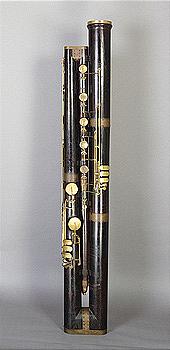| The contrabassophone was invented around 1850 by the German bassoon maker Heinrich Joseph Haseneier, as a substitute for the contrabassoon (which at that time was too muffled to be satisfactory). The contrabassophone differed from the contrabassoon by having a larger bore (made of wood, and doubled in a similar fashion), and large tone holes covered by padded keys (without trying to duplicate the long oblique fingerholes found in bassoons). The resulting instrument was considered too powerful to play with an orchestra. The instrument is very rare: only a few copies were made by Haseneier, and a few later copies were made by Alfred Morton. It has a fingering system similar to the Boehm system, with single keys for L1-3 and R1-3, two keys R4, one or two keys for L4, with two keys for RT and four keys for LT. The lowest note is C1, "contrabass C" (the lowest C on the piano or contrabassoon). |  |
| One can find pictures of the contrabassophone, as well
as an excellent article, in Tom Dibley, "A Contrabassophone by Alfred Morton"
The
Galpin Society Journal (April 2000) LIII:60
(sorry, the text is not online), and in Gunther Joppig's article in the
IDRS
Journal (also printed at Journal of the American Musical Instrument
Society, Vol. XII, 1986, pp. 68-106) (picture alone here).
To see one in person, try the Shrine to Music Museum in Vermillion, South Dakota (http://www.usd.edu/smm/BASSOON.HTM#bassophon) |